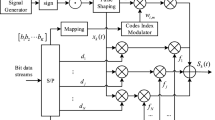Abstract
An exact method is employed to analyze the bit error rate (BER) performances of differential chaos shift keying (DCSK) communication system over fading channels. The exact BER performances of DCSK in Nakagami-m Rayleigh and Rician fading channels are derived, respectively. The Gaussian approximation (GA) method is compared with the exact method. The numerical results and simulation results for the two methods are presented and are compared in the fading channels, respectively. These results support our theoretical analysis.
Similar content being viewed by others
References
Kennedy, M. P., Koluman, G., & Jako, Z. (1998). Recent advances in communicating with chaos. In Proceedings of the IEEE International Symposium on Circuits and Systems (pp. 461–464). USA: Monterey, CA.
Kolumbán G. et al (1998) FM-DCSK: A robust modulation scheme for chaotic communications. IEICE Transactions on Fundamentals of Electronics Communications and Computer Sciences E81a(9): 1798–1802
Salberg A.B., Hanssen A. (2006) A subspace theory for differential chaos-shift keying. IEEE Transactions on Circuits and Systems Ii-Express Briefs, 53(1): 51–55
Ji Y., Lawrance A.J. (2006) Performance analysis and optimization of multi-user differential chaos-shift keying communication systems. IEEE Transactions on Circuits and Systems I, Fundamental Theory and Applications, 53(9): 2075–2091
Mandal S., Banerjee S. (2004) Analysis and CMOS implementation of a chaos-based communication system. IEEE Transactions on Circuits and Systems I-Regular Papers, 51(9): 1708–1722
Delgado-Restituto M., Acosta A.J., Rodriguez-Vazquez A. (2005) A mixed-signal integrated circuit for FM-DCSK modulation. IEEE Journal of Solid-State Circuits, 40(7): 1460–1471
Lawrance A.J., Ohama G. (2003) Exact calculation of bit error rates in communication systems with chaotic modulation. IEEE Transactions on Circuits and Systems I-Fundamental Theory and Applications, 50(11): 1391–1400
Mandal S., Banerjee S. (2002) Performance of differential chaos shift keying communication over multipath fading channels. IEICE Transactions on Fundamentals of Electronics Communications and Computer Sciences, E E85-A: 1–10
Nakagami, M. (1960). The m-distribution—a general formula for intensity distribution of rapid fading. Pergamon Press.
Suzuki H. (1977) A statistical model for urban radio propagation. IEEE Transactions on Communications, 25(7): 673–680
Charash U. (1979) Reception through nakagami fading multipath channels with random delays. IEEE Transactions on Communications, 27(4): 657–670
Geisel T., Fairen V. (1984) Statistical properties of chaos in Chebyshev maps. Physics Letters A, 105(6): 263–266
Simon, M. K., & Alouini, M. S. (2000). Digital communication over fading channels-A unified approach to performance analysis. Wiley.
Johnson N.L., Kotz S., Balakrishna N. (1995) Continuous univariate distributions (Vol. 2, 2nd ed). Wiley, New York
Author information
Authors and Affiliations
Corresponding author
Rights and permissions
About this article
Cite this article
Zhou, Z., Wang, J. & Ye, Y. Exact BER Analysis of Differential Chaos Shift Keying Communication System in Fading Channels. Wireless Pers Commun 53, 299–310 (2010). https://doi.org/10.1007/s11277-009-9685-4
Received:
Accepted:
Published:
Issue Date:
DOI: https://doi.org/10.1007/s11277-009-9685-4




